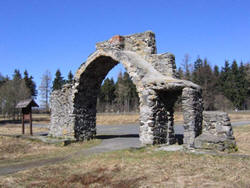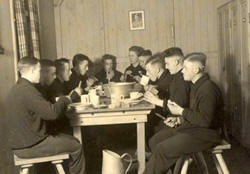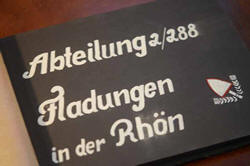RAD in the RhoenGeoff Walden and Bob
Stefanowicz
Beyond Manteuffel Kaserne, what other relics of the Nazi
period were hiding in plain sight during the American era in
Bad Kissingen and the greater Rhoen region? Geoff Walden,
TACOM - Schweinfurt, between many tours to Iraq, has been
working to answer that question and has sent scans and
photos that clarify one of the many small roadside mysteries
found in our former border area. While on U.S. Patrol, if
you ever went down one of those asphalt farm access roads in
the Fladungen - Rudenschwinden - Leubach area and noticed a
rather impressive stone archway that led … no where. Here is
what you found.
Reichsarbeitdienst
Beginning in the early 1930s, while Germany still
suffered mass unemployment from an economic depression that
brought near collapse to the economic system, a national
program was begun to find work for the thousands of men who
otherwise were idle. The Reicharbeitdienst, Governmental
Labor Service, often abbreviated as RAD, was built upon an
earlier existing tradition in Germany of voluntary labor
formations formed to provide productive activity for youth
and unemployed adult workers.
Once the Third Reich was fully established, the RAD was
refined. In the Nazi context, the labor organization
expanded its mission to include basic para military training
and indoctrination that service to the German state and
service to Hitler were one in the same.
In the late 1930s, as the economy revived, the need to
find work for older men decreased and the RAD was staffed by
a near universal conscription program for young men at the
age of seventeen. The men would spend approximately ten
months to one year in Spartan labor camps learning the
virtues of manual labor, team work, military discipline and
service to the Reich.
Most but not all camps were located in the vast farm and
wood tracks of Germany and could usually accommodate about
200 men . The men were assigned to public works projects
such as road building, quarry work or land reclamation. The
government was careful to not engage the RAD in direct
completion with private sector construction firms. In some
respects, the RAD closely resembled the Civilian
Conservation Corps programs in the USA during the same
period.
Getting the road built was important, but the Reich saw
an almost equal benefit in the exposure of the young men to
the hard labor and discipline associated with the
construction projects. The RAD was organized on distinctly
military lines. In addition to the basics of civil
construction, the men learned to wear a uniform and follow a
rank structure with a chain of command. Life in the rustic
camps paralleled life in a military garrison and during
parades, the RAD men marched with their symbolic shovel, a
motif of their manual labor and a close surrogate for a
rifle. After RAD service, most men could expect to be
drafted into the Wehrmacht for two years. Formal military
training began where the basic indoctrination the young men
received in the labor organization had left off.
The command and leadership cadres of the RAD were career
positions to which the men could aspire; a somewhat similar
program existed for the young women of the Third Reich. The
RAD program continued during the course of the war, units
labored both within Germany and, increasingly, at the far
flung fronts in direct construction support of the Wehrmacht.
For a very good English language history of the
Reicharbeiterdiesnt, follow this link :
http://www.feldgrau.com/rad.html
Fladungen
In the 1930s, the area between Bischofsheim running north
to Fladungen and then across the now gone border towards
Kaltennordheim was a site of intense RAD labor pulled
together by a powerful local political leader, Gauleiter
Hellmuth. The central feature of his civil improvement “
Plan “ was the construction of the Hochrhoenstrasse, a major
new road through the woods, marshes and hilly terrain of his
political base in that region of Bavaria - Thuringia. The
construction provided RAD jobs for hundreds of young men and
the Fladungen area was a hub for the project with several
RAD camps within just a few square kilometers.
Abt.
- Abteilung, a work company / The official numerical
designation / When adopted - the honorary company title /
General location
Abt. 4/282 Stangenroth
Abt. 5/283 ( 1/288 ) “ Der Heidelstein der Hohen Rhoen “ Fladungen
area
Abt. 6 /283 ( 2/288) “ Kaiser Heinrich II “ Fladungen area
Abt. 3/288 ( no definitive location found )
Abt. 6/288 near Leubach
Abt.5/288 in Rudenschwinden
Many of the camps were rough and ready consisting of
wooden barracks with coal stoves, a mess hall, parade field
and perhaps some utility buildings. The longer the labor
Abteilung remained in one area, however, the more features
their camp developed. Photographs of the Fladungen camp
reveal that the RAD men had the opportunity to do much
finish carpentry and stone work to make their home a
regional show place.
During the war years, the RAD camps of the Rhoen took on
a new mission and were used to provide pre induction
military training for the youth of the region. The training,
lasting about one month, was skill specific and the
Fladungen camp, because of its high elevation, focused on
the basics of military radio and telegraph communications.
Other camps taught introductory driver skills and infantry
fundamentals. All students received training in the
politics, history and philosophy of the Nazi Party.
How long the RAD construction units continued work on the
Hochrhoenstrasse is unknown but certainly by 1942,
requirements of the war would have seen local construction
projects scaled back or ended.
In the modern day, the local road network tracks along
many of the areas first cleared and graded by the RAD men.
Long after their roadside monuments were removed and
barracks pulled down, only the basalt door arch remains in
silent testimony to what was once the largest RAD barracks
in the Fladungen area.
Slideshows
Click on the picture below to view |
|
|
 |
|
 |
|
Radlagertor Fladungen |
|
RAD Lager Rundenschwinden |
 |
|
 |
|
RAD Lager Laubach |
|
2nd Fladungen Album |
(updated September 2012)